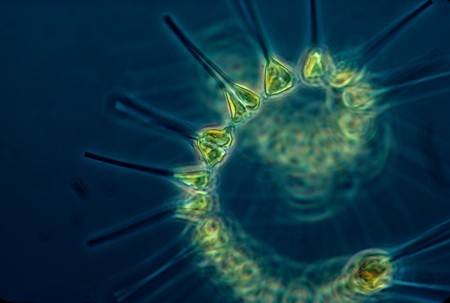New Study Reveals Marine Plankton Generates Brighter Clouds
| KJ Belonio | | Jul 20, 2015 07:52 PM EDT |
(Photo : Wikimedia Commons) Phytoplankton, which is a tiny organism in the sea that produces airborne gases and organic matter to seed cloud droplets, can lead to brighter clouds that reflect more sunlight.
What do our skies look like before fossil fuel started burning? Or how clouds form? Or How clouds help set the temperature of the earth? The answers to these questions are unknown until a recent study was published online.
On July 17, a recent study helmed by the University of Washington and the Pacific Northwest National Laboratory was published in Science Advances, an open-access Science journal. The research revealed how tiny natural particles given off by marine organisms, nearly doubled cloud droplets numbers in the summer, according to Phys.org.
Like Us on Facebook
By combining computer modelling and satellite data over the Southern Ocean, the study estimated how much solar energy equates to the vast sea surrounding Antarctica.
"It is a strong effect," Department of Energy's Pacific Northwest National Laboratory climate scientist Susannah Burrows said. "But it makes sense because most of the area down there is ocean, with strong winds that kick up a lot of spray and lots of marine microorganisms producing these particles. And continental aerosol sources are mostly so far away that they only have a limited impact. Really the marine aerosols are running the show there."
Based on the study, phytoplankton, which is the tiny organisms in the sea that produces airborne gases and organic matter to seed cloud droplets, lead to brighter clouds that reflect more sunlight, University of Washington Today reported.
"The clouds over the Southern Ocean reflect significantly more sunlight in the summertime than they would without these huge plankton blooms," co-lead author Daniel McCoy, a UW doctoral student in atmospheric sciences, stated. "In the summer, we get about double the concentration of cloud droplets as we would if it were a biologically dead ocean."
Furthermore, the clouds form when droplets of water condense out of the air around tiny particles and it turns out that the particle size creates a direct impact on cloud brightness. Smaller particles form small droplets creating more surface area which reflect back incoming sunlight, which in turn help keeps the Earth's surface cooler, Gizmodo noted.
Burrows and co-author Daniel McCoy at the University of Washington worked with other colleagues from the University of Leeds. The research was funded by NASA, the U.S Department of Energy and a graduate fellowship from the Air Force Office of Scientific Research. Other co-authors of this study are Pro-Lun Ma and Phil Rasch at the Pacific Northwest National Laboratory and Scott Elliott at Los Alamos National Laboratory.
TagsPlankton, Marine Plankton, Study, Science
©2015 Chinatopix All rights reserved. Do not reproduce without permission
EDITOR'S PICKS
-

Did the Trump administration just announce plans for a trade war with ‘hostile’ China and Russia?
-

US Senate passes Taiwan travel bill slammed by China
-

As Yan Sihong’s family grieves, here are other Chinese students who went missing abroad. Some have never been found
-

Beijing blasts Western critics who ‘smear China’ with the term sharp power
-

China Envoy Seeks to Defuse Tensions With U.S. as a Trade War Brews
-

Singapore's Deputy PM Provides Bitcoin Vote of Confidence Amid China's Blanket Bans
-

China warns investors over risks in overseas virtual currency trading
-

Chinese government most trustworthy: survey
-

Kashima Antlers On Course For Back-To-Back Titles
MOST POPULAR
LATEST NEWS
Zhou Yongkang: China's Former Security Chief Sentenced to Life in Prison

China's former Chief of the Ministry of Public Security, Zhou Yongkang, has been given a life sentence after he was found guilty of abusing his office, bribery and deliberately ... Full Article
TRENDING STORY

China Pork Prices Expected to Stabilize As The Supplies Recover

Elephone P9000 Smartphone is now on Sale on Amazon India

There's a Big Chance Cliffhangers Won't Still Be Resolved When Grey's Anatomy Season 13 Returns

Supreme Court Ruled on Samsung vs Apple Dispute for Patent Infringement

Microsoft Surface Pro 5 Rumors and Release Date: What is the Latest?










